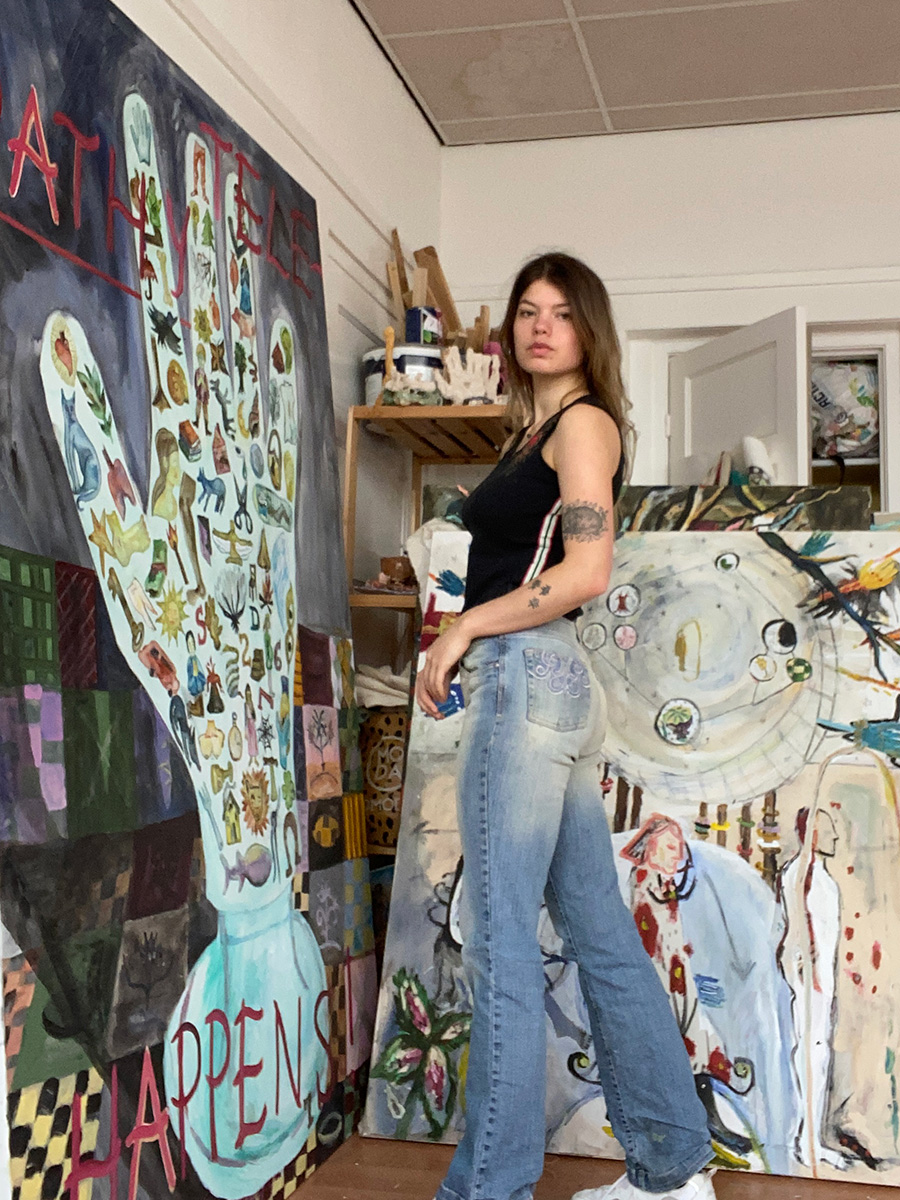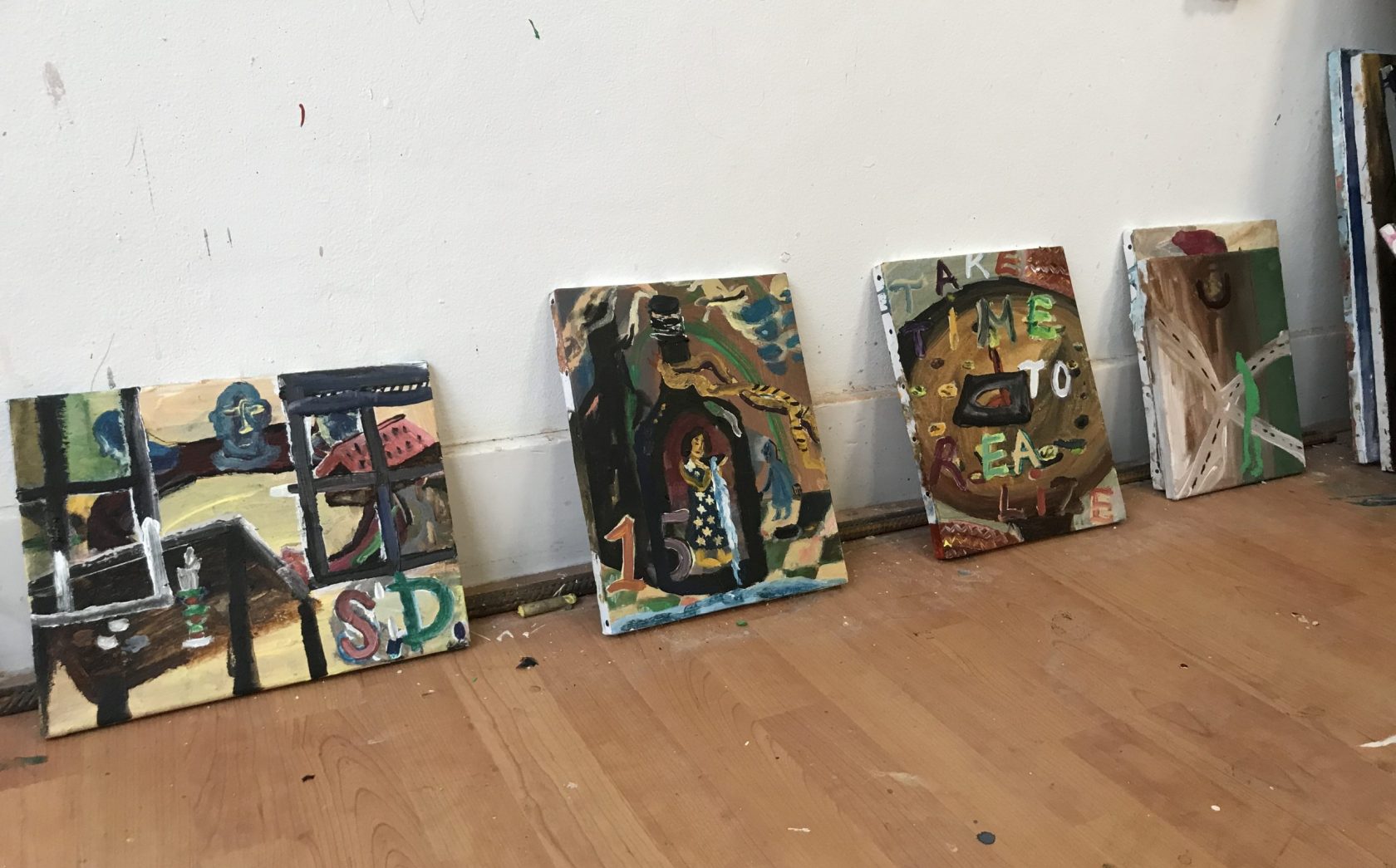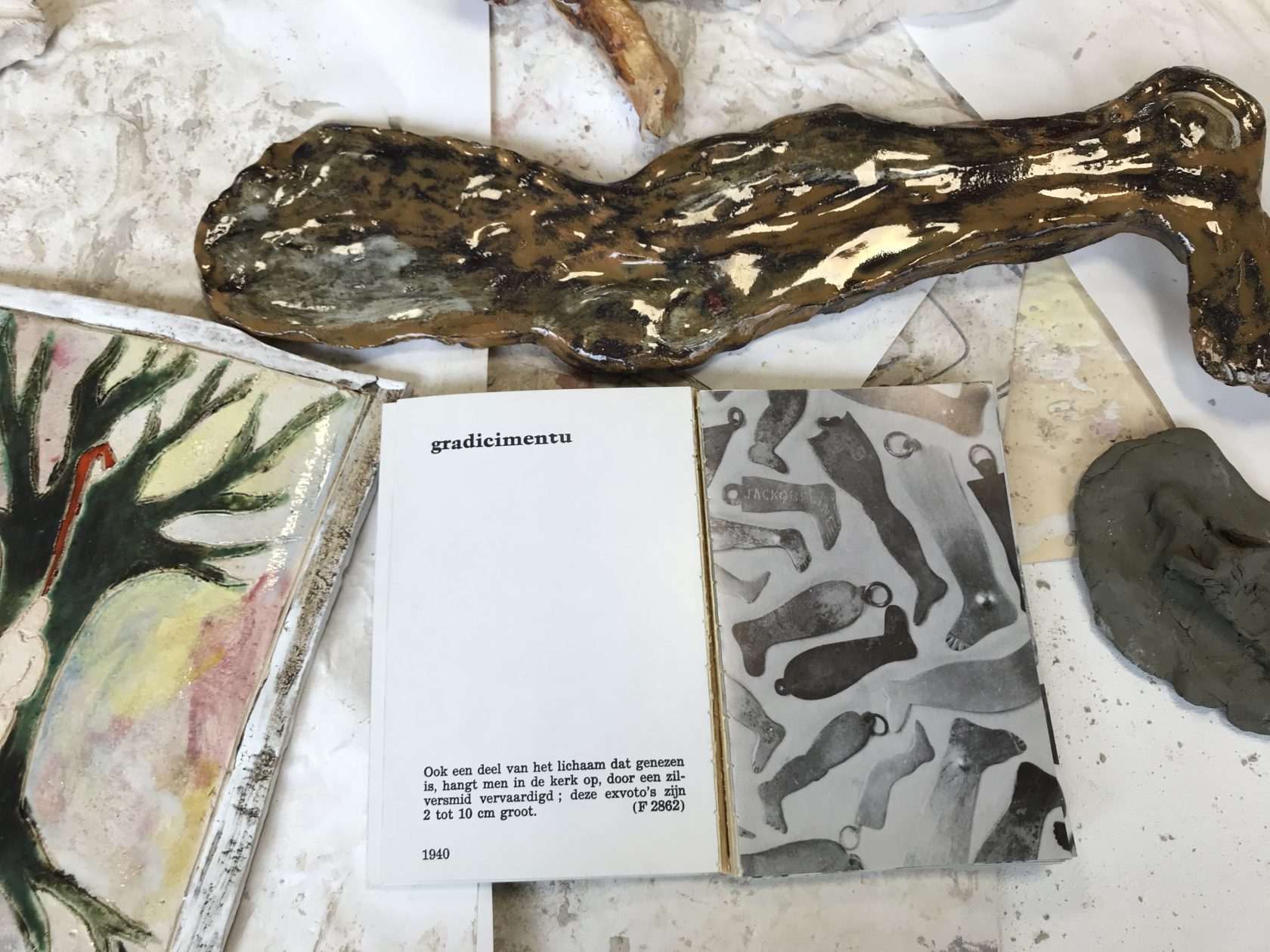Stroom invest interview / artist Shani Leseman
A beautiful former school building set up in Nieuwe Haagse School-style in the centre of The Hague, houses makerspaces to different creatives. This is where I’m meeting Shani Leseman, artist and witch-to-be. Art as an exercise for gratefulness.

One of the classrooms is now Shanis studio, which is a spacious room with lots of light coming in. There are paintings leaning against the wall, a newly finished one standing in front, ceramic works hanging on the wall. There’s a ceramics oven, and small ceramic tablets with pigment-tests next to it. We sit down on the couch with a good view on the big painting in the middle. Using five questions we have an interesting conversation about magic, art, Curaçao and energy within a work of art.
Can you describe what you do?
I am investigating magic in everyday life. Through my witch training, I discover topics and exercises I can use and process in paintings and ceramic objects.
This work is called Telepathy Happens, it’s just finished, and I’m finally comfortable enough to present it here and online on my website. It was a strange process making this piece. I notice that my work is becoming more and more spiritual and in this particular work I felt I was being guided. I received guidance from a certain energy that showed me this image. I obviously made it myself, I can clearly see my handwriting in it, but when comparing it with other works of mine, I can see this is not a typical way of working for me. For instance, normally I use many different layers on top of each other, or sometimes I use gesso to start a certain piece of the painting anew, so again adding a new layer. But in this painting it’s just the tiles, the hand and the text. So merely three layers.

The hands are noticeably present in all of my work, I’m not really sure why. It’s like an unconscious symbol that keeps returning. The shape is quite important, but the symbolic meaning seems even more important: Hands are what people use to create something with, to heal with, hands are important points from where energy flows. When I think of energy healing, hands are the starting points. For example, if there’s a sudden pain somewhere in your body, your hand reaches for that place, to comfort and to reassure yourself. I think that’s a very beautiful thing.
Depicting the different figures on the hand is a much more deliberate choice. I once found a wooden hand on a fleamarket, it was sculptured all over with these little figures. They are called milagros, which is the spanish word for miracles. Each of those charms has its own purpose and meaning, and also on Curaçoa they’re used to practice magic.
I lived in Curaçao until I was 9 years old. A natural understanding of magic, the conviction that for a certain wish you can go see someone who practices magic and who helps you, is something I have most certainly brought with me. For example, in the pharmacies in Curaçao painkillers like aspirin and so on, are right next to the charms and the incense and the bracelets, they’re all displayed on the same shelf. When I’m back there it really strikes me, to have these two alternatives for the same purpose, ie getting better, presented together so self-evident.


What drives you to make work?
To secure or fix research and any new things that come to mind. I could not not do it, it’s a desire to capture things like this. I just really like to look and to create, and it’s a beautiful way to analyze life and marvel at it by creating.
Everyone has the urge to create, art is connected in being human, people need to make art. It is an expression of everything that lives. Even embroidering a tablecloth, it’s a practical useful thing, but you can make it as beautiful as you want, put as much love and focus and originality in it as you can. People want to make beautiful things and like looking at them. If we shouldn’t create, life energy would stop flowing.
In my training to being a witch I notice many similarities between witch practice and my art practice. I can apply a great deal of what I learn from this training in my art practice and vice versa. Like the creative power in making a ritual, for example the drafting of an altar. A witch picks out certain elements that have their own individual symbolic value. She takes a bowl and a cloth and some candles, all intuitively chosen parts of an altar but she’s so well trained to be able to put this together in the right setting and for the right purpose. Composing a painting also works that way; you intuitively choose your material, elements, subjects, and the canvas becomes the altar. Intuition, intention and an associative way of working, these are very significant in my witch training and in my practice as an artist as well.
Witches make altars for other people, I guess although it differs per painting, I made this as an altar for someone else as well. It carries out the message so clearly: “Look, it exists and this happens!” and that’s what I want to show, that’s the goal in this particular ritual.
How would you like people to engage with your work?
I would like people to feel instead of think. In fact, I’d like it if my work-process continues in the minds of the viewer. I love how associations can continue and personal stories are created. Ultimately, I hope to achieve that they’re able to see the world with a magical glance. To see what magical things happen every day and to discover it is not something distant but actually natural, ordinary and daily to be using magic.
So basically people should turn off their thinking when they look at my work, and start feeling more. I want them to stop and consider ‘I feel, as a person’. This way of engaging is part of my investigation; what do I feel, what do I think. To dwell on that in a meditative way, to sit back, fully relax and observe from there. To see and think about ‘what does this work of art tell me, what do I feel about it, what is that? What relationship can I establish with this object, can I communicate with it and can it do something for me?’

Do you have anything exciting planned?
Yes definitely! I’m very excited about showing the series of talismans in the Stedelijk Museum Amsterdam this November. The work will be part of the biannual Municipal Art Acquisitions-show. This year’s theme for the open call was Guna Guna, the silent power (or, black magic) of Indonesia. It is in fact exactly like Brua (compilation of spirituality, witchcraft and superstition of Curaçao culture) in every way.
In my final year at the art academy I discovered how well the process of ceramics suits me. I like the idea of putting such time and energy into it: forming it, letting it dry, waiting, baking, sometimes the object breaks so starting the process again… It requires much work, it’s laborious and also very direct. I can actually hold this material in my hands, and that makes me feel there is more to it, it carries more of the energy we talked about.
My energy is literally captured in it since I created it, but there’s an intention in it as well, because I have spent considerable time with it, and because the object is formed so slowly. When you’re holding something that has been made this way, the object itself feels as if the intention has taken on a physical form.
Right now I’m working on this series of hundred talismans. I read Paul Brennekers research on the folklore of Curaçao, Aruba and Bonaire, in which he writes about charms as ex voto (by the virtue of the vow), which really intrigued me. Charms are, among other things, used to give thanks for a wish that has come true, or for help that was received. People put these charms up on the churches wall to give thanks, they are a reminder and a daily reflection on what you have received and on what is going well. This idea of gratitude for healing is such a beautiful thing to me. It shows that art becomes a daily tool and is of practical use; I had two knee on both knees surgeries ahead of me and I felt the need to make two charms. Now those two little knees are on my wall at home, so every day I have a reminder to be grateful for my healed knee. To create something to give thanks for all the beautiful things that happened, art as exercise in gratitude, that’s a truly wonderful thing.
Another thing I look forward to is the sterrentuin this summer. I’m curating an exhibition in our garden, which is so inspiring to do. I invited twelve artists to work on a theme. It’s inspiring to see them starting out working on it in their own way and use their personal interpretation and process, and then watch them and their works come together here in our garden.

What’s your connection to The Hague?
I studied at the Koninklijke Academie voor Beeldende Kunst in The Hague. I think The Hague is a socalled friendly and homely city, it has a small artscene where everyone knows one another. There’s enough space to work at your own pace and ease, and at the same time there’s a strong connection between everyone, there’s lots of support. I wish for The Hague everything the talismans represent: happiness, care, good health, riches and prosperity.
Stroom Invest Week is an annual 4-day program for artists who were granted the PRO Invest subsidy. This subsidy supports young artists based in The Hague to develop their artistic practice so that artists and graduates of the art academy can continue to live and work in The Hague. To give the artists extra incentive, Stroom organises this week consisting of studio visits, presentations and several informal meetings. The intent is to broaden the visibility of artists from The Hague through future exhibitions, presentations and exchange programs. Stroom Invest Week 2022 will take place from 7 to 10th of June.